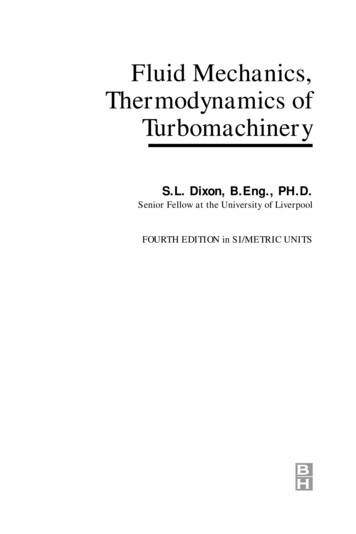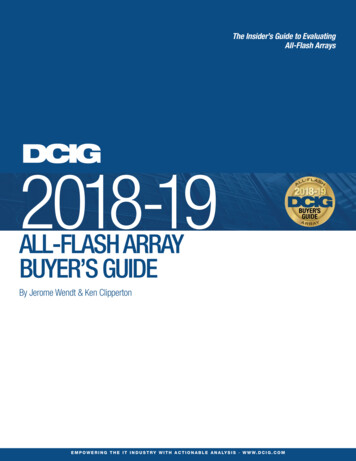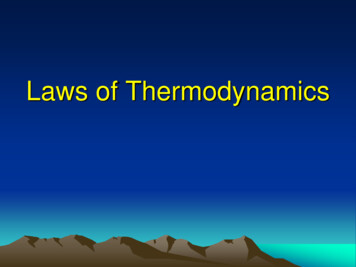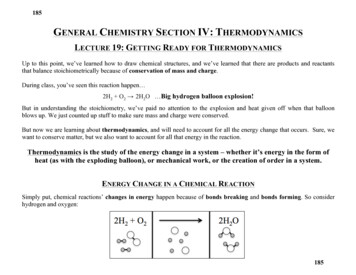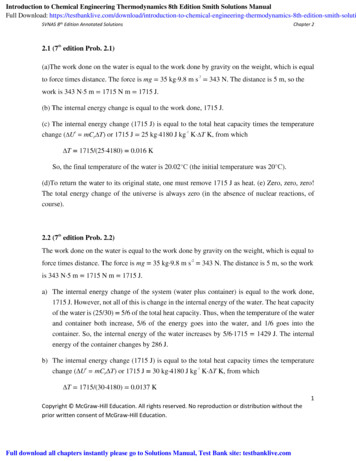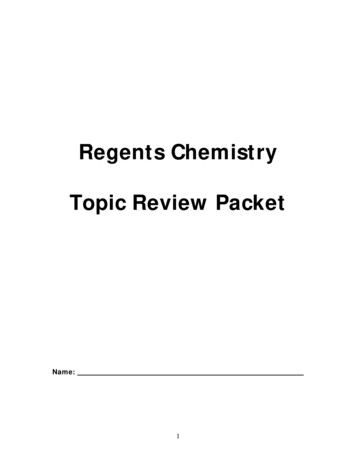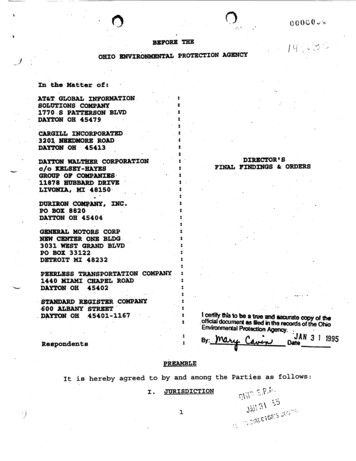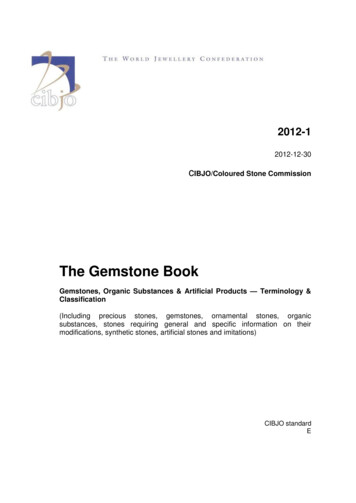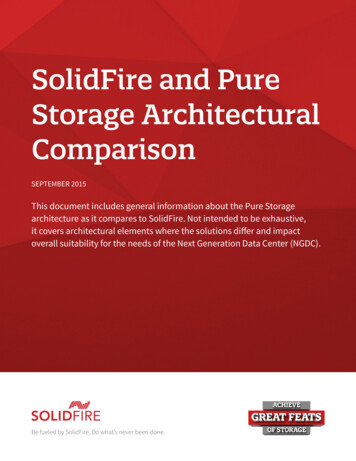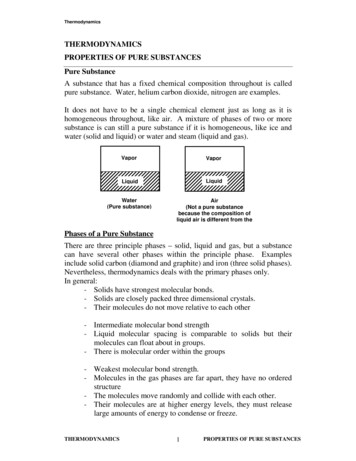
Transcription
ThermodynamicsTHERMODYNAMICSPROPERTIES OF PURE SUBSTANCESPure SubstanceA substance that has a fixed chemical composition throughout is calledpure substance. Water, helium carbon dioxide, nitrogen are examples.It does not have to be a single chemical element just as long as it ishomogeneous throughout, like air. A mixture of phases of two or moresubstance is can still a pure substance if it is homogeneous, like ice andwater (solid and liquid) or water and steam (liquid and gas).VaporVaporLiquidLiquidWater(Pure substance)Air(Not a pure substancebecause the composition ofliquid air is different from thecomposition of vapor air)Phases of a Pure SubstanceThere are three principle phases – solid, liquid and gas, but a substancecan have several other phases within the principle phase. Examplesinclude solid carbon (diamond and graphite) and iron (three solid phases).Nevertheless, thermodynamics deals with the primary phases only.In general:- Solids have strongest molecular bonds.- Solids are closely packed three dimensional crystals.- Their molecules do not move relative to each other- Intermediate molecular bond strength- Liquid molecular spacing is comparable to solids but theirmolecules can float about in groups.- There is molecular order within the groups- Weakest molecular bond strength.- Molecules in the gas phases are far apart, they have no orderedstructure- The molecules move randomly and collide with each other.- Their molecules are at higher energy levels, they must releaselarge amounts of energy to condense or freeze.THERMODYNAMICS1PROPERTIES OF PURE SUBSTANCES
ThermodynamicsPhase – Change Processes Of Pure SubstancesAt this point, it is important to consider the liquid to solid phase changeprocess. Not so much solid to liquid because thermodynamics deals onlywith liquid to gases (or vice versa) to generate power.Consider water at room temperature (20 C) and normal atmosphericpressure (1 atm) in a piston-cylinder device. The water is in liquid phase,and it is called compressed liquid or subcooled liquid (not about tovaporize).CompressedliquidLiquid(Point 1)If we add heat to water, its temperature will increase; let us say until50 C. Due to the increase in temperature, the specific volume v willincrease. As a consequence, the piston will move slightly upwardtherefore maintaining constant pressure (1 atm).CompressedliquidLiquidNow, if we continue to add heat to the water, the temperature willincrease further until 100 C. At this point, any additional addition of heatwill vaporize some water. This specific point where water starts tovaporize is called saturated liquid.(Point 2)THERMODYNAMICS2PROPERTIES OF PURE SUBSTANCES
ThermodynamicsLiquidSaturatedliquidIf we continue to add heat to water, more and more vapor will be created,while the temperature and the pressure remain constant (T 100 C and P 1 atm). The only property that changes is the specific volume. Theseconditions will remain the same until the last drop of liquid is vaporized.At this point, the entire cylinder is filled with vapor at 100 C. This stateis called saturated vapor(Point 4)The state between saturated liquid (only liquid) and saturated vapor (onlyvapor) where two phases exist is called saturated liquid-vapor mixture.(Point NAMICS3PROPERTIES OF PURE SUBSTANCES
ThermodynamicsSaturatedvaporVaporAfter the saturated vapor phase, any addition of heat will increase thetemperature of the vapor, this state is called superheated vapor(Point 5)Figure 3: T-v diagram representing phase change for water at constantpressure.This concept can be applied to pure substance other than water.THERMODYNAMICS4PROPERTIES OF PURE SUBSTANCES
ThermodynamicsSaturation Temperature And Saturation PressureRecall that during a phase change, pressure and temperature are notindependent intensive properties. As a consequence, the temperature atwhich water starts boiling depends on the pressure. In other words, waterstarts boiling at 100 ºC but only at 1 atm. At different pressures, waterboils at different temperatures.At a given pressure, the temperature at which a pure substance changesphase is called the saturation temperature (Tsat).Likewise, at a given temperature, the pressure at which a pure substancechanges phase is called the saturation pressure (Psat).Property Diagrams for Phase Change ProcessesT-v DiagramIf we increase the pressure of water in the piston-cylinder device, theprocess from compressed liquid to superheated vapor will follow a paththat looks like the process for P 1 atm, the only difference is that thewidth of the mixture region will be shorter.Then, at a certain pressure, the mixture region will be represented only byone point. This point is called the critical point. It is defined as the pointat which the saturated liquid and saturated vapor states are identical.At the critical point, the properties of a substance are called criticalproperties (critical temperature (Tcr), critical pressure (Pcr) and criticalspecific volume (vcr)).ExampleWaterPcr 22.09 MPaTcr 374.148 C 647.298 Kvcr 0.003155 m3/kgAirPcr 3.77 MPaTcr 132.5 C 405.65 Kvcr 0.0883 m3/kgTHERMODYNAMICS5PROPERTIES OF PURE SUBSTANCES
ThermodynamicsFigure 4: T-v diagram.If we connect all the points representing saturated liquid we will obtainthe saturated liquid line.If we connect all the points representing saturated vapor we will obtainthe saturated vapor line.The intersection of the two lines is the critical point.Figure 5: T-v diagram and saturation lines.THERMODYNAMICS6PROPERTIES OF PURE SUBSTANCES
ThermodynamicsP-v DiagramIf we consider the pressure-cylinder device, but with some weights abovethe piston, if we remove the weights one by one to decrease the pressure,and we allow a heat transfer to obtain an isothermal process, we willobtain one of the curves of the P-v diagram.Figure 6: P-v diagram.The P-v diagram can be extended to include the solid phase, the solidliquid and the solid-vapor saturation regions.As some substances, as water, expand when they freeze, and the rest (themajority) contracts during freezing process, we have two configurationsfor the P-v diagram with solid phase.THERMODYNAMICS7PROPERTIES OF PURE SUBSTANCES
ThermodynamicsFigure 7: P-v diagram for a substance that contracts during freezing (left)and for a substance that expends during freezing (right).Triple pointUntil now, we have defined the equilibrium between two phases.However, under certain conditions, water can exist at the same time as ice(solid), liquid and vapor. Theses conditions define the so called triplepoint.On a P-T diagram, these conditions are represented by a point.ExampleWaterT 0.01 C 273.16 K and P 0.6113 kPaFigure 8: P-T diagram and the triple point.The P-T diagram is often called the phase diagram since all three phasesare separated by three lines.Solid vaporSolid liquidLiquid PROPERTIES OF PURE SUBSTANCES
ThermodynamicsP-T-v DiagramFigure 9: P-T-v diagram for a substance that contracts during freezing(left) and for a substance that expends during freezing (right).Property TablesIn addition to the temperature, pressure, and specific volume data, tablescontain data for the specific internal energy u, the specific enthalpy h,and the specific entropy s.In thermodynamics analysis, we will encounter the combination ofproperties U PV frequently. For simplicity this combination is definedas a new property called enthalpy.H U PV(kJ)The enthalpy per unit mass ish u Pv(kJ/kg)THERMODYNAMICS9PROPERTIES OF PURE SUBSTANCES
ThermodynamicsSaturated Water TablesSince temperature and pressure are dependent properties using the phasechange, two tables are given for the saturation region. Table A-4 hastemperature as the independent property; Table A-5 has pressure as theindependent property. These two tables contain the same information.TABLE A-4Saturated water-Temperature tableThe last entry is the critical point at 373.95 oC.TABLE A-5Saturated water-Pressure tableThe last entry is the critical point at 22.064 MPa.The subscript fg used in Tables A-4 and A-5 refers to the differencebetween the saturated vapor value and the saturated liquid value region.That is,u fg u g u fh fg hg h fs fg s g s fThe quantity hfg is called the enthalpy of vaporization (or latent heat ofvaporization). It represents the amount of energy needed to vaporize aunit of mass of saturated liquid at a given temperature or pressure.THERMODYNAMICS10PROPERTIES OF PURE SUBSTANCES
ThermodynamicsQuality and Saturated Liquid-Vapor MixtureNow, let’s review the constant pressure heat addition process for watershown in Figure 3 (pg 4). Since state 3 is a mixture of saturated liquidand saturated vapor, how do we locate it on the T-v diagram? Toestablish the location of state 3 a new parameter called the quality x isdefined as:mgmass of saturated vapor total massm f mgx The quality is zero for the saturated liquid and one for the saturated vapor( 0 x 1 ). The average specific volume at any state 3 is given in terms ofthe quality as follows. Consider a mixture of saturated liquid andsaturated vapor. The liquid has a mass mf and occupies a volume Vf. Thevapor has a mass mg and occupies a volume Vg.We noteV V f Vgm m f mgV mv, V f m f v f , Vg mg v gmv m f v f mg v gv THERMODYNAMICSmf vfm 11mg vgmPROPERTIES OF PURE SUBSTANCES
ThermodynamicsUsing the definition of the quality xx mgmf m mgm f mgThenmm mgm 1 xNote, quantity 1- x is often given the name moisture.volume of the saturated mixture becomesThe specificv 1 x v f x v gThe form that we use most often isv v f x vg v f It is noted that the value of any extensive property per unit mass in thesaturation region is calculated from an equation having a form similar tothat of the above equation. Let Y be any extensive property and let y bethe corresponding intensive property, Y/m, theny y f x y g y fmy y f x y fgy where y fg y g y fThe term yfg is the difference between the saturated vapor and thesaturated liquid values of the property y; y may be replaced by any of thevariables v, u, h, or s.We often use the above equation to determine the quality x of a saturatedliquid-vapor state.The following application is called the Lever Rule:THERMODYNAMICS12PROPERTIES OF PURE SUBSTANCES
Thermodynamicsx y yfy fgThe Lever Rule is illustrated in the following figures.Superheated Water TableA substance is said to be superheated if the given temperature is greaterthan the saturation temperature for the given pressure.State 5 in Figure 2-3 (page 3) is a superheated state.In the superheated water Table A-6, T and P are the independentproperties. The value of temperature to the right of the pressure is thesaturation temperature for the pressure. The first entry in the table is thesaturated vapor state at the pressure.Superheated vapor is characterized by:Lower pressure (P Psat at a given T)Higher temperature (T Tsat at a given P)Higher specific volumes (v vg at a given P or T)Higher internal energies (u ug at a given P or T)Higher enthalpies (h hg at a given P or T)THERMODYNAMICS13PROPERTIES OF PURE SUBSTANCES
ThermodynamicsCompressed Liquid Water TableA substance is said to be a compressed liquid when the pressure is greaterthan the saturation pressure for the temperature.It is now noted that state 1 in Figure 2-3 (page 3) is called a compressedliquid state because the saturation pressure for the temperature T1 is lessthan P1.Data for water compressed liquid states are found in the compressedliquid tables, Table A-7. Table A-7 is arranged like Table A-6, except thesaturation states are the saturated liquid states. Note that the data in TableA-7 begins at 5 MPa or 50 times atmospheric pressure.At pressures below 5 MPa for water, the data are approximately equal tothe saturated liquid data at the given TEMPERATURE. We approximateintensive parameter y, that is v, u, h, and s data asy y f @TThe enthalpy is more sensitive to variations in pressure; therefore, at highpressures the enthalpy can be approximated byh h f @ T v f P Psat For our work, the compressed liquid enthalpy may be approximated byh hf @TCompressed liquid is characterized by:Higher pressure (P Psat at a given T)Lower temperature (T Tsat at a given P)Lower specific volumes (v vg at a given P or T)Lower internal energies (u ug at a given P or T)Lower enthalpies (h hg at a given P or T)THERMODYNAMICS14PROPERTIES OF PURE SUBSTANCES
ThermodynamicsHow to Choose the Right TableThe correct table to use to find the thermodynamic properties of a realsubstance can always be determined by comparing the known stateproperties to the properties in the saturation region. Given thetemperature or pressure and one other property from the group v, u, h, ands, the following procedure is used. For example if the pressure andspecific volume are specified, three questions are asked: For the givenpressure,is v v f ?is v f v v g ?is v v g ?The answer to one of these questions must be yes. If the answer to thefirst question is yes, the state is in the compressed liquid region, and thecompressed liquid tables are used to find the properties of the state. If theanswer to the second question is yes, the state is in the saturation region,and either the saturation temperature table or the saturation pressure tableis used to find the properties. Then the quality is calculated and is used tocalculate the other properties, u, h, and s. If the answer to the thirdquestion is yes, the state is in the superheated region and the superheatedtables are used to find the other properties.Some tables may not always give the internal energy. When it is notlisted, the internal energy is calculated from the definition of the enthalpyasu h PvTHERMODYNAMICS15PROPERTIES OF PURE SUBSTANCES
ThermodynamicsEquations of StateThe tables with which we have been working provide an accuraterelationship between temperature, pressure and other importantthermodynamic properties. If we restrict consideration to only the vaporstate, then we may often find a simple algebraic relationship betweentemperature, pressure and specific volume; such a relationship is calledan equation of state.For gases at low pressure it has been observed that pressure, P, is directlyproportional to temperature, T, (this is known as Charles’ law) andinversely proportional to specific volume, v (Boyle’s law).P R TvHere, R is known as the gas constant.It is further found that there is a relationship between the various gasconstants and the molecular weight of the particular gas. Specifically, itis found that the product of the gas constant and the gas molecular weightyields the same constant for all gases. This product is known as theUniversal Gas Constant.THERMODYNAMICS16PROPERTIES OF PURE SUBSTANCES
ThermodynamicsJacques Alexandre César Charles (November 11, 1746 - April 7,1823) was a French inventor, scientist, mathematician, and balloonist.Circa 1787 he discovered Charles' Law, which states that underconstant pressure, an ideal gas' volume is proportional to itstemperature. The volume of a gas at constant pressure increaseslinearly with the temperature of the gas. The formula he created wasV1/T1 V2/T2. His discovery anticipated Joseph Louis Gay-Lussac'spublished law of the expansion of gases with heat (1802).Charles was elected to the Institut Royal de France, Académie dessciences, in 1793, and subsequently became professor of physics atthe Conservatoire des Arts et Métiers. He died in Paris on April 7,1823.Robert Boyle (January 25, 1627 – December 30, 1691) was an Irishnatural philosopher, chemist, physicist, inventor, and early gentlemanscientist, noted for his work in physics and chemistry. Although hisresearch and personal philosophy clearly has its roots in the alchemicaltradition, he is largely regarded today as the first modern chemist. Amonghis works, The Sceptical Chymist is seen as a cornerstone book in thefield of chemistry.Therefore, the gas constant for a specific (R) gas is equal to:R RuMThe Universal gas constant is considered a fundamental constant, similarto the gravitational constant.RU 8.314 kJ/kmol KAlternate forms of the ideal gas law:P·v R·TP ·R·TP·V m·R·TP·V N·Ru·TRemember that: mass (m) Number of moles (N) Molecular Mass (M)Following the ideal gas law, for a process form (1) to (2), we can write:P1V1 P2V2 T1T2THERMODYNAMICS17PROPERTIES OF PURE SUBSTANCES
Thermodynamics THERMODYNAMICS 1 PROPERTIES OF PURE SUBSTANCES THERMODYNAMICS PROPERTIES OF PURE SUBSTANCES Pure Substance A substance that has a fixed chemical composition throughout is called pure substance. Water, helium carbon dioxide, nitrogen are examples. It does not have to be a single chemical element just as long as it is .

